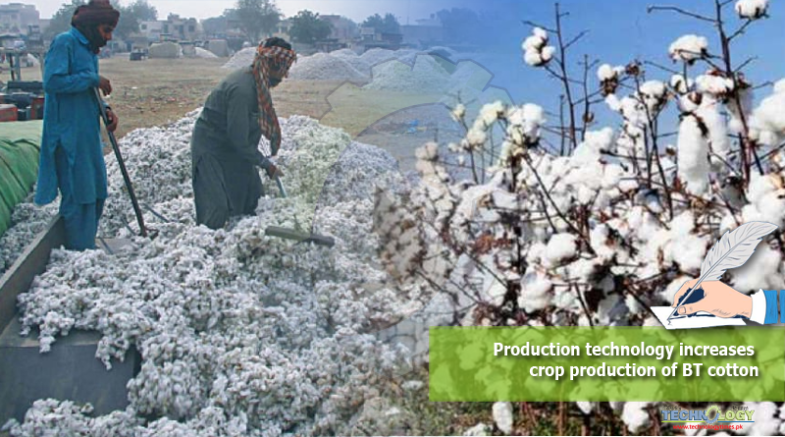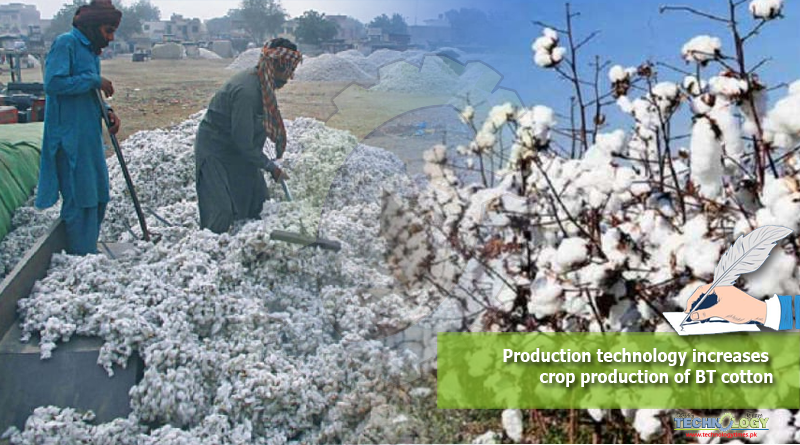Using the production technology, crop production of BT cotton increases up to 35 Mond. Cotton is the major crop of Pakistan. Pakistan export up to 60% by products of cotton. Furthermore 38% people of Pakistan associated with the Cotton business. Punjab is the biggest producer of cotton which produce up to 73%.

For the last 5 years’ cotton production decreases in Pakistan due to multiple factors i.e. high temperature, insect attack, attack of Cotton leaf curl viruses (CLCV).
Using the following production technology, crop production increases up to 35 Mond.
For the better production of cotton soil should be fertile, plane, healthy and have minerals in good amount. For preparing soil plough twice in soil and used one-time rotavator for leveling then again plough and then sow the seed of cotton.
Approved varieties
- Multan region: FH-142, MNH- 886, IUB-13, Cyto-179, AGC- 999, BS-15
- Dera Ghazi Khan region: FH-142, MNH- 886, IUB-13, Tarzen-3, Cyto-179, CIM-602, BS-15
- Bahawalpur region: FH-142, MNH- 886, IUB-13, Cyto-78, AGC- 999, BS-15, CIM-602, FH lalazar, RH-668
- Sahiwal region: IUB-13, Nayab-878, Tarzen-3,
- Faisalabad region: FH lalazar, FH-142, Nayab-878, NIBGI-3, IUB-13
Time of sowing
To get the maximum yield and avoid the crop from pest and diseases, best time of sowing is 1st April to 31st May.
Seed rate
Seed should be healthy, protected from diseases and it should be approved variety. Eat to get 10 kg e seed is used per acre.
Seed treated with poison
To protect the crop from sucking insect, seed is treated with the chemicals i.e. imidacloprid 70 WS 10 gm per kg. This protect the crop from sucking pest in initial first month.
Cultivation method
With the drill: Use kharif drill, maintain the plant to plant distance of 2.5 feet and seeds should be in soil up to 2.5 inch.
Sowing at ridges: After irrigation place the seed with the help of hand in soil and maintain plant to plant distance up to 6-9 inches.
Number of plants: The sowing of April must have 23000 plants and showing of may must have 35000 plant
Fertilizer: Use nitrogen phosphorus potassium with the ratio of 2.5:1:1 respectively. Phosphorus is needed during root formation and potash and nitrogen used for flower and ball formation. Furthermore, for the poor soil use to bag off DAP, 1.5 SOP and 3 bags of urea. For the average soil use 1.5 bag DAP, 1.5 bag SOP and 3 bad urea. For the healthy and fertile soil use 1.25 bag of DAP, 1.5 bag SOP, and 3 bags of urea.
For the deficiency of zinc and boron use zinc sulphate 33% 5 kg and Boric acid 17% 2.5 kg per acre.
Control of weeds
At the time of sowing, spray herbicide to control the weeds. Crop should be saved from weeds for 60 days. After 75 to 80 days spray glyphosate 1000-1200 ml with shield or foam nozal.
- Pendimethalin 33EC 1 liter
- Methaclore. 960 EC. 800 ml
- Methaclore+ pendimethalin 960 EC 900 ml
Protection from diseases
CLCV is major cotton. It is transmitted through white fly. To control CLCV, why flies control should be insured. Virus affected crop treated with zinc sulphate 200gm, borax 200 gm, potassium nitrate 200 gm and urea 1 kg e mix with 100 liter of water and separate on the crop for three times with a gap of 15 days.
There are two type of insect pest of cotton one is Sucking insect like White fly, aphid, thrips, dusky cotton bug, mealybug. The other type is Chewing insects like Pink boll worm, army worm, American boll worm.
Following are the management of some major pest.
White fly (Bemisia tabaci)
Whitef ly is major pest of cotton. It sucks the cell sap. It has multiple host crops i.e. Cotton, Sunflower, Tori, Cauliflower, Cabbage, Melon, Potato, peas, tomato etc.
In cotton it attacks in the early stage of crops effect the growth of crop and also spoiled the quality of lint. In the recent year, due to maximum sprays, white fly develop resistance in it and now it is difficult to control.
Causes of white fly expansion
- Excessive of use of nitrogen.
- Decrease in water level in the field, increase in the glucose level in crop and then chances increase of white fly attack.
- Irregular use of Potash and phosphorus result in increased number of white fly nymph.
- Excessive use of pesticide result in increased resistance in white fly.
Non Chemical Control
- Avoid cultivation of alternate hosts near the cotton fields and also destroy weed hosts and crop stubble’s including cotton sprouts as they may harbour white fly and virus.
- Avoid over-irrigation of cotton field.
- Chrysoperla sp. C hrysopidae) and Brumus sp. (Coccinellidae) are effective predators of its nymphs and adults in June to August-September.
- .com Eretmocerus massii (Aphilinidae) and Encarsia sp. can cause about 33% and 5-10% parasitization, respectively of its nymphs and pupae in the field.
Chemical control
- Imidacloprid 200 SL 250 ml/acre.
- Diafenthiuron 500 SC 200-250 ml/acre
- Acetamiprid 20 SP 125 ml/acre
- Buprofezin 25 WP 500 g/acre
- Spinosald 240 SC 80 ml/acre
Thrips ( Thrips tabaci )
The adults as well as nymphs do damage. The nymphs start feeding on plant juices after lacerating the leaf tissues. The insects can be easily seen by the naked eyes found moving fastly on the leaves and flowers.
On onion and garlic, the nymphs are usually congregated at the base of a leaf or in the flowers. On cotton, cabbage and cauliflower, they generally feed on the under surface of the leaves.
It is a serious pest of cotton in hot and dry conditions. Both adults and nymphs attack usually early cotton seedlings. By leaf rasping the pest sucks up the exuding sap. In case of severe pest attack on cotton, leaves become wrinkled and fall off and cause opening of premature bolls.
Lower leaves are severely damaged during attack. Infested leaves become silvery white, then dirty white and ultimately become crumple shaped. The plants bear very few bolls.
In case of onion and garlic, leaves at first become curled, wrinkled and gradually dry up. There is no bulb or seed formation in case of severe attack.
Chemical Control
- imidacloprid 100 SL 75 ml/acre.
- acetamiprid 20 SP 125 g/acre.
- diafenthiuron 500 SC 200-250 ml/acre.
- spinosad SC 40 ml/acre:
- deltamethrin + triazophos 36 EC 500 ml/acre.
Pink Boll worm ( Pectinophora gossypiella )
Pink boll worm is serious pest of cotton. The caterpillars only in various ways as under cause damage: The pest causes shedding of squares, flowers and then bolls.
However, the attack of this pest is at worst from 15th August to last week of September/first week of October. The larva enter the squares and such squares blossom into “Rosette flowers'”. Later on the larva entering the bolls leave no sign of their entrance outwardly. Inwardly the entrance point becomes bulgy.
The damaged bolls fall off pre-maturely and those, which do mature, produce lint of highly poorer quality. This fetches low price in the market as oil comes out of the damaged seeds inside the bolls due to high field temperature and results yellow spots in cotton. The damaged seed-cotton gives a lower ginning percentage, lower oil extraction and inferior spinning quality.
The infestation of this pest causes excessive shedding of the fruiting bodies. Of the total shedding, 52-90% caused by all the boll worms collectively, half may be due to the attack of pink boll worm. It has been observed that by controlling the pink boll worm and the spotted boll worm, cotton yield can be increased up to 50%
Non-chemical control
- Use PB ropes to disturb their mating.
- Destruction of off-season cotton-sprouts and alternate host plants or plant debris reduces its population.
- After last picking, grazing of sheep and goats on unwanted bolls in the field reduces pest attack in the next season.
- Deep ploughing to bury affected bolls after harvesting by the end of February reduces carryover of this pest to the next season.
- Trichogramma chilonis destroys its eggs before pink caterpillars hatch out while its larvae are parasitized by Apanteles sp., Bracon sp. and Chelonus sp.
- Anthocorid bug, Triphles sp. (Anthocoridae) feeds on eggs and first instar larvae.
Chemical control
- Endosulphan 35 EC, 1000-1250 ml/acre.
- Spinosad 240 EC, 80 ml/acre.
This article is jointly written by Faheem Shoukat, Department of Entomology, MNS- University Agriculture, Multan, Punjab, Pakistan and Zohaib Afzal, Department of Soil Science, MNS- University of Agriculture, Multan, Punjab, Pakistan.
